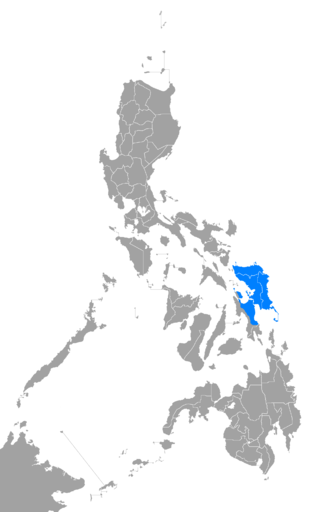
Back Waray-Waray Afrikaans ዊናራይኛ Amharic لغة واراي واراي Arabic لغه الواراى الواراى ARZ Waray AST Varay dili Azerbaijani Tataramon na Waray-Waray BCL Варайская мова BE-X-OLD Winarayeg Breton Waray-waray Catalan
This article includes a list of general references, but it lacks sufficient corresponding inline citations. (May 2015) |
| Waray | |
|---|---|
| Waray-Waray, Samar-Leyte Visayan | |
| Winaray, Samareño, Lineyte-Samarnon, Binisayâ nga Winaray, Binisayâ nga Samar-Leyte | |
| Native to | Philippines |
| Region | Eastern Visayas, some parts of Masbate, southern part of Sorsogon, and Gibusong Island of Mindanao |
| Ethnicity | Waray |
Native speakers | 3.6 million (2015 census)[1] |
Austronesian
| |
| Dialects | Standard Waray (Tacloban dialect), Northern Samar dialect, Calbayog dialect, Culaba-Biliran dialect, Abuyog dialect and 20 other identified dialects and subdialects |
| Latin; Historically Baybayin | |
| Official status | |
Official language in | Regional language in the Philippines |
| Regulated by | Komisyon sa Wikang Filipino Historically regulated by the Sanghiran san Binisaya ha Samar ug Leyte |
| Language codes | |
| ISO 639-2 | war |
| ISO 639-3 | war |
| Glottolog | wara1300 |
 Areas where Waray-Waray is spoken | |
Waray (also known as Waray-Waray or Bisayâ/Binisayâ nga Winaray/Waray, Spanish: idioma samareño meaning Samar language) is an Austronesian language and the fifth-most-spoken native regional language of the Philippines, native to Eastern Visayas. It is the native language of the Waray people and second language of the Abaknon people of Capul, Northern Samar, and some Cebuano-speaking peoples of western and southern parts of Leyte island. It is the third most spoken language among the Bisayan languages, only behind Cebuano and Hiligaynon.
- ^ Waray at Ethnologue (19th ed., 2016)
